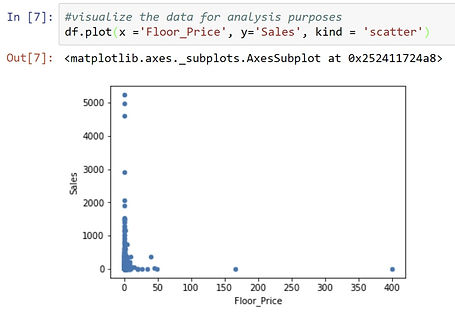PROJECT 1
In the following project, we are asked to define a problem and show our data understanding over a dataset we have chosen.

Introduce the problem
The problem I am trying to solve is does a collection having a different floor price in Solana or USA dollars affects how many NFTs are sold from a collection?
Introduce the data
I found this data from a source called Kaggle and basically this data overviews NFT collections that are sold by two different currencies: Solana and US dollars. It features the different sales based on the different types of currencies, the average price of an NFT in a particular collection, their floor prices, the type of NFT they are(category), and what is the lowest price for any NFT in a particular collection.
Feel free to view the data here!
_edited.jpg)
Pre-processing the data
1. Check the data- see what the file type I am using, the attributes(columns) the data includes, review the meaning of the data(read the explanations given by Kaggle for the different components and features of the dataset).
2. See if there are any errors within the dataset, for example, any missing values/null values. So I saw there were some missing values like, link to the collection and/or type of collection it is-category, for some NFT collections but it was easy to find them because I had their names and logos, so I traced back to those sources' by using those two attributes to be able to get each collections associated link and category type. A key thing I did when it came to my pre-processing process is after I reviewed a majority of the rows I could see a pattern in how each collection is categorized, which was as "Digital/Art/Collectible", but I did catch 1 or 2 collections that identified as "Trading" or "Fashion" so I was able to mark those collections as their correct category. But since there was not a lot of categories that do not fall into "Fashion" or "Trading", I made the assumption of categorizing the rest of the collections that have missing categories with just the default category, "Digital" , because as NFT collections they all will always be Digital so that is why you may see that some of the collections' category is denoted as "Digital." Next, to numerical attributes, I realized the only numerical attributes that are left empty is "Floor_Price" and "Floor_Price_USD", based on my research the floor price is usually set by the seller so I thought of the possibility that the seller did not set a floor_price at all, so all of the entries under that column that were left empty I replaced with a zero.
Data Understanding/Visualization
I do find it very important with this dataset, in particular, to visualize it because, since I have replaced numerical values that were missing, like the zeros in the "Floor_price" category will affect the visualization. So based on the visualization when the floor_price is zero for either Solana or US dollars, the sales would still remain high (view the graphs for each type of currency provided by the dataset below), which I believe makes sense if the buyers for some of the NFT collections are used to paying a high value because they understand how unique the NFT they receive will be. That is what the artist/seller will promise them when they sell it to them.
Floor Price - Solana
_edited.jpg)
Floor Price - US dollars
_edited.jpg)
Storytelling
Imagine you are a prospective buyer on an NFT collectible website, like "Stylish Studs" for instance, and you are promised a cool hand-drawn skull that is custom to you. Now as an NFT buyer you do know that a seller offers one or two things, an average price, and a floor price. But in some cases the floor price may not be given, meaning the owner may not
want to sell their product at a lower value than they have listed. So, the prospective buyer realizes how valuable and unique each skull collectible can be so they pay the average price from the owner. Imagine this scenario played out for other NFT collections. But the catch is some NFT sellers may want to have a floor price and others may not. I
realized the floor price does not have a big indication on whether an NFT collection will sell more or less but it does give me possible scenarios that help me understand the seller and the buyer more. But, in conclusion, the true indicator on how much a person is willing to sell a product and buy a product is identifying if the product is good, level of how good it is shows much an artist/seller values their product and how much the buyer should hold value to it in return.
(source: Skeleton Crew Skulls) - the example NFT used in my explanation.
My Code
You can view the code I wrote for my project here.